Wall and ceiling decoration with wet (liquid) wallpaper
Several years ago, liquid wallpaper appeared on the market of finishing materials. Gradually they are becoming more and more popular, as they can be operated for 5-8 years without losing their appearance, even in the hallway or corridor. Among the advantages of this coating are safety, high maintainability, plasticity, which allows you to easily finish arches, columns, and other complex surfaces.
The content of the article
What it is
Liquid wallpaper is sometimes confused with decorative plaster. Probably because the application technique is very similar. - with a spatula. The fundamental difference is that the composition of the applied mass is completely different. Any plaster contains sand, and cement and lime are used as a binder. The composition of liquid wallpaper includes silk, cotton, cellulose fibers. As a binder - some kind of glue.
For coloring the composition, acrylic dyes are usually used, and in order to obtain a surface of different types, sparkles of different sizes, pieces of mica, mother of pearl, threads, and other natural or artificial materials are added. These decorative additives are called "glitters".
How they look on the wall
In terms of appearance, liquid wallpaper is a cross between plaster and paper wallpaper. From the store, you bring a dry composition to which, according to the instructions, add a certain amount of water. The resulting semi-liquid mass is applied to the walls or ceiling. The coating is seamless due to the ductility of the material; during application, minor surface defects are corrected - gouges, cracks, etc. Due to the same plasticity, it is not too difficult to form a drawing, even a picture.
So on the wall, liquid wallpaper looks different. Differences are added by a different composition. If it is a silk-based liquid wallpaper, the surface has a characteristic matte sheen. This composition is also called "liquid silk". The cellulose and cotton variation is matte, even in the same shade and with the same decorative additives, the wall looks different.
And there are also mixed compositions - cellulose-silk or cotton-silk, in which there is some degree of gloss, but not so pronounced. In general, it's hard to say what liquid wallpaper looks like on a wall. If you like decorative plaster, you should also like this finish.
Views
Liquid wallpaper is distinguished by its composition. As already mentioned, they are made on the basis of natural fibers. By the type of these fibers, they are:
- silk;
- cotton;
- cellulosic.
They differ not only in composition, but also in appearance. It is difficult to convey this in pictures - the difference in the presence and type of gloss, its brightness, visual "looseness" or surface smoothness. Of all the options, the most expensive silk compositions. More budgetary - cotton and cellulose.
Advantages and disadvantages
If we talk about the general impression, some people like liquid wallpapers, some do not. But their properties are not bad. The advantages include the following qualities:
- Seamless surface. No seams like wallpaper. Smooth surface.
- If necessary, the disadvantages of the walls are evened out, but the consumption of the composition increases.
- The composition is vapor-permeable, that is, it does not create problems for maintaining normal humidity in the room.
- Fits well on curved surfaces of any complexity.
- Easy restoration for any kind of damage. There are two possibilities:
- in case of minor damage (scratches), just wet, wait a couple of minutes and smooth with a spatula;
- in case of a color change or a significant defect - clean off the old coating, apply a patch.
- Additional heat and sound insulation.
- When flooded, they remain on the wall, practically do not change their appearance after drying. The main thing is, while they are wet, do not touch anything.
- If you don’t like how the coating “lasts”, you can remove it from the wall, soak it and reapply.
Quite good qualities. Most impressive is its high maintainability. This is good when you have pets: scratches are simply erased. If you also like this surface, you should give it a try.
Liquid wallpaper also has disadvantages:
- Burn out in the sun. This must be borne in mind in the southern room.
- Clean only dry: dust can be collected with a vacuum cleaner and a soft brush.
- Stubborn dirt, grease cannot be removed. Just remove the contaminated piece and apply a patch.
- Not all surfaces fit well. The easiest way is to work with rough ones, the worst of all - with absolutely smooth ones (the composition “flows down”).
- For a good result, surface preparation is necessary - leveling out significant irregularities, priming in several layers. If the surface is unevenly colored, painting is also needed (usually white).
- Self-application takes a long time.
As you can see, there are some pretty serious drawbacks. The most unpleasant thing is the impossibility of wet cleaning. In the hallway or in the kitchen, this is not always acceptable. This disadvantage can be leveled by covering the wall with varnish. It can be washed, but it cannot be restored. In addition, the varnished coating loses its vapor permeability, but becomes water-repellent.
Application technique
Although manufacturers say that liquid wallpaper can be applied to curved walls, it is better not to do this. There are two points. The first is increased material consumption. Considering that the cost of liquid wallpaper is not too low (one package is required for 4-5 m², but it costs from $ 5 to $ 18, although there is also $ 40), it is cheaper to prepare the surface. The second point is that if there are significant differences, a pronounced "spotting" may result. Darker will be the areas where the liquid wallpaper has laid down in a thick layer, and lighter where the layer is thin (due to the wall being translucent). This again leads to an increase in consumption - for color equalization.
Surface preparation
The first step is to remove the old decorative coating. We peel the wallpaper to the bare wall, and if it bubbles and peels off, we also remove the paint. Then we smooth out the irregularities. As already mentioned, it is better to make the wall at least more or less even.
A smooth (or relatively flat) wall should be coated with a primer several times. This will reduce the absorbency of the surface, making it easier to work.
According to experience, liquid wallpaper is best applied to rough walls, such as plaster. So it is desirable for the primer to give a similar effect. Of the ready-made compositions, this is "Betonokontakt". After its application, the wall becomes a little "viscous" in sensations, grains of sand adhering to the surface make it rough. Any composition perfectly fits on such a basis. There is also a cheaper option for priming walls for liquid wallpaper - the most inexpensive white water emulsion (2 parts) with PVA glue (1 part). Cover with a primer (any) at least twice.
If the wall has an uneven color, and the primer did not hide it, you will also have to paint it. Because when a thin layer is applied, darker and lighter areas will show through. You can take the most inexpensive water-based paint and paint the wall with it.A perfectly even color is not needed, there should be no sharp transitions.
One more point. If there are metal fragments in the wall - nails, screws, etc., it is advisable to remove them. If you can't remove it, paint the area with some kind of water-repellent paint in the same color as the base. If this is not done, while the liquid wallpaper dries, the metal will rust, and the rust will "come out" with an ugly yellow spot. We'll have to repair it right away. So it is better to insulate all metal objects in advance.
Preparation of the composition
Liquid wallpaper is sold dry in bags. Before use, water is added to the composition, everything is well mixed. The amount of water depends on the volume of the bag, type of composition, manufacturer. The specific quantity is written on the package.
It is more convenient for this work to have a large plastic bucket - 12 liters or more. The contents of the bag are poured into it, water is added. The mixture must be mixed until smooth. It turns out something like minced meat.
Since liquid wallpaper does not contain harmful chemical additives, you can stir it with your hands. If the mass is unpleasant for you, you can wear gloves. The finished mass is usually transferred back to the bag, the "neck" is twisted and left for several hours (at least 4-5 hours, but preferably 10-12) - for uniform swelling. Please note that the dried composition will be noticeably lighter than the wet one.
It is better to knead at once the entire amount necessary to decorate a room or at least one wall. Borders may be visible if placed in pieces. They are almost invisible in light shades, but can ruin the picture if the color is bright. If the boundaries are still visible before the wall is completely dry, no action should be taken. Perhaps the borders will disappear when completely dry. If the liquid wallpaper has dried, but transitions are visible, the composition can be removed with a spatula, soaked again for several hours, mixed and applied again.
Wall or ceiling application
Take a new trowel for work. To make it easier to follow the process, there is a trowel with a transparent plastic work surface. It is easier for beginners to work with such a trowel. The process itself is simple:
- A small amount of the soaked composition is applied to the plane.
- Rub on the wall in a circular motion.
- They put in a new batch of material, continue from the same place.
It is advisable to process the entire wall at one time, otherwise the lines of the joint between the two "pieces" may be visible. If, nevertheless, it was not possible to process the entire wall at a time, sprinkle the joint well with water, wait 20-25 minutes, you can continue finishing. Most likely, the joint will be subtle or almost invisible.
In the corners, you can use a regular spatula, but it is easier to make even corners using special corner ones. First, a mass is applied on both sides of the corner, carried out with an angular spatula, while the excess squeezed out is rubbed from the corner - onto the wall, leveling the surface.
Liquid wallpaper dries for a long time - about 48 hours. The composition contains a substantial amount of water, so that when it dries in a room, high humidity, which inevitably gets into other rooms. But in the process, you can turn on the heating, open windows, make a draft. There are no restrictions.
Roller application
Applying liquid wallpaper with a trowel or spatula is good for everyone, except that the process takes a lot of time. To speed up the process, you can try applying liquid wallpaper with a roller. Only the roller should be special: with stiff short hairs, collected in groups. In width - about 15 cm. If you have not found one, you can use fur with a hard short nap or foam rubber, but hard.
Before starting work, dilute the liquid wallpaper according to the instructions, prepare the wall.Then try to work with the resulting composition. If the mass is poorly distributed over the wall, add a little water. But add a little, because too liquid will "creep". The technique is slightly different:
- Apply some mass to the wall with a trowel, not worrying too much about the thickness of the layer. Just make a "blooper".
- Roll out with a roller.
- Apply the next batch of solution, roll out.
The roller makes it easier to maintain the same material thickness. This works well on flat walls. Moreover, the finishing speed is 6-8 m².
When applying liquid wallpaper with a roller, the surface is rougher and more textured. If you don't like this effect, after the wall is finished, moisten it with a spray bottle, wait 15 minutes, walk over the surface with a clean trowel soaked in water, smoothing the relief.
How to make patterns with liquid wallpaper
It is unlikely that beginners will be able to make complex patterns on the walls with liquid wallpaper, but it is quite possible to try something simple. The easiest way to make two-color patterns, and easier - geometric.
Any image can be found. But then you need to transfer the outline of the drawing to the wall. If you have artistic talent, you can try to do it by hand. If it does not work, you can enlarge to the required size, print on paper, but better on cardboard, cut out and attach to the wall. Fill around with one wallpaper color. When the liquid wallpaper is dry, peel off the paper / cardboard using a second to fill the empty area. But you need to work carefully, without getting the finished part dirty.
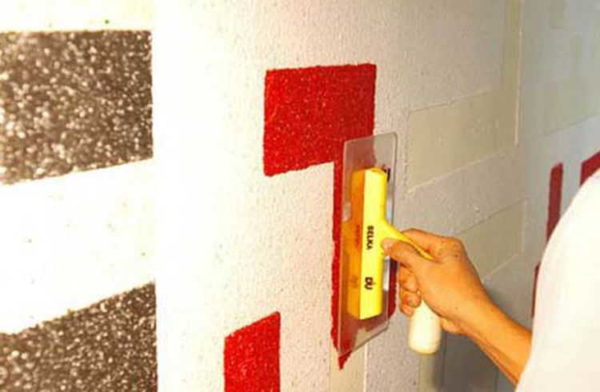
After removing the paper or cardboard template, a cavity remains, which is filled with material of a different color
If the drawing is simple - geometric shapes, for example, you can set some kind of rigid barrier to separate colors. For example, beacons for plastering. They are fixed, filled with liquid wallpaper of the same color. After drying, you can remove the beacons and carefully, without crawling onto the finished part, use the second color.
There is also a way to transfer complex drawings without printing. You will need glass, black marker, lamp. Draw a contour on the glass with a black felt-tip pen, highlight it with a lamp. A clear outline appears on the wall, which we simply direct. We fill in the way that is more convenient, but usually large areas first, then smaller ones.


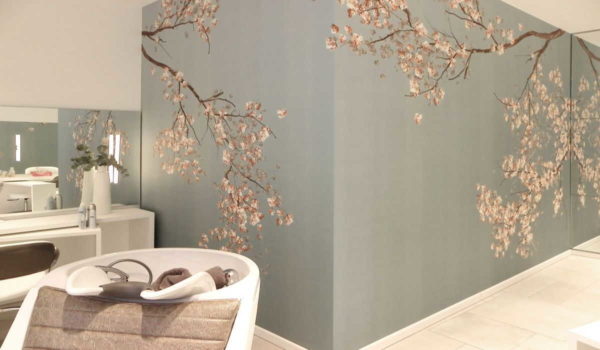
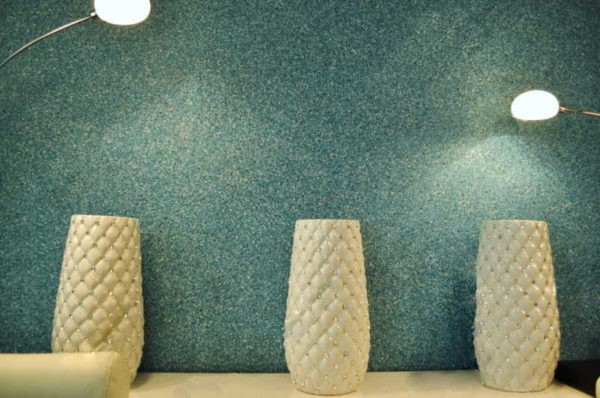
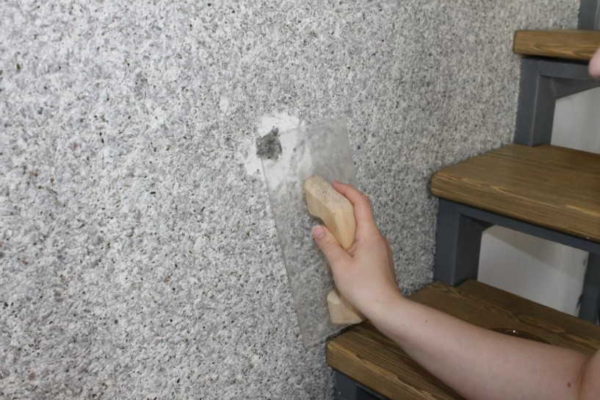
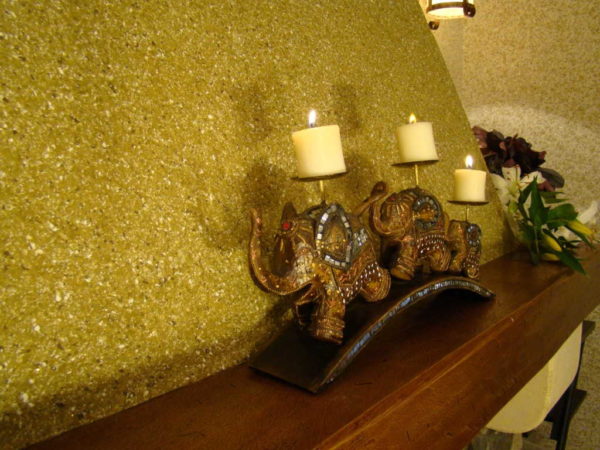
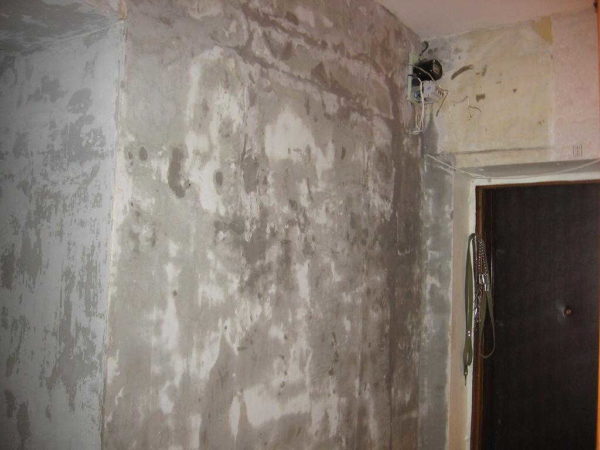
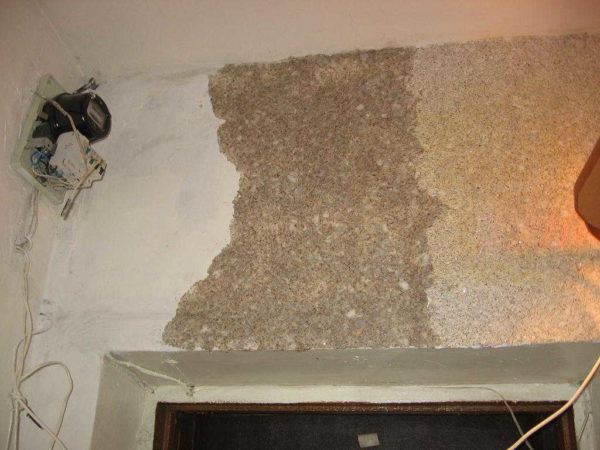

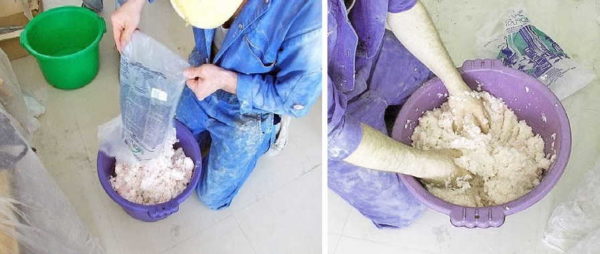
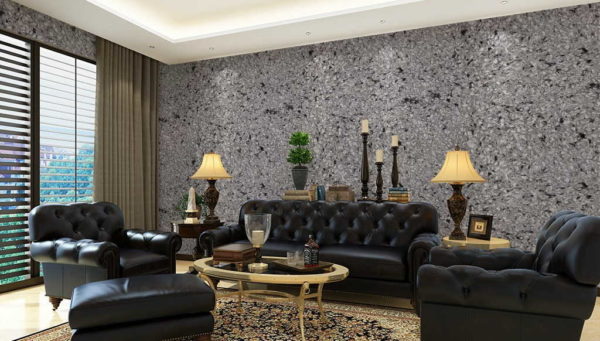
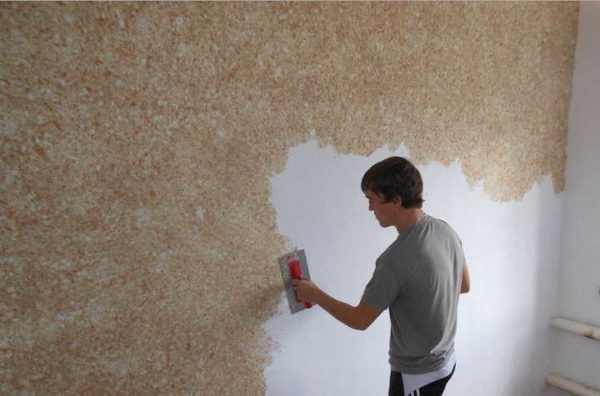

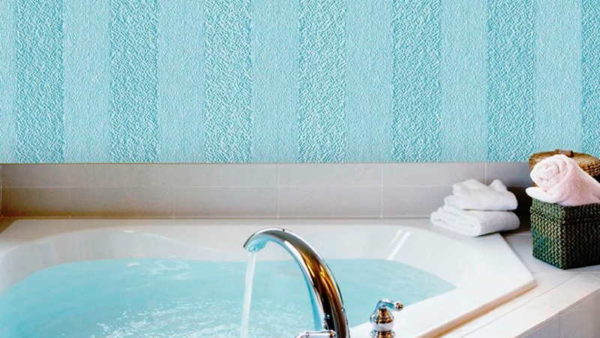

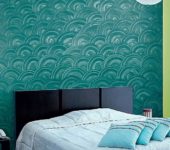
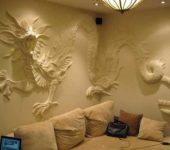
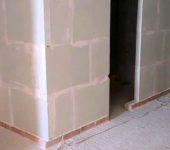
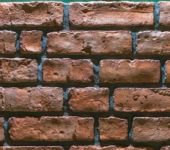





Nice and thorough article. Thank you. But I, as a master who has been working with the application of liquid wallpaper for 5 years, will allow myself to disagree with the following: “Not all surfaces fit well. The easiest way is to work with rough ones, the worst of all - with absolutely smooth ones (the composition “flows down”). "
The answer is. In my opinion and experience, liquid wallpaper fits well on any surface. To do this, you just need to specially prepare the material. If the task is to prevent it from "flowing" from the wall, just add less water while mixing. The liquid wallpaper contains glue that copes with the task of retaining a viscous material on any surface, including the ceiling. The only emergency event in my memory happened at that moment. when I applied liquid wallpaper to the wall in 40 degree heat. The red-hot walls of the panel house turned out to be immediately attached to the walls .. I had to wait for the evening and continue working.